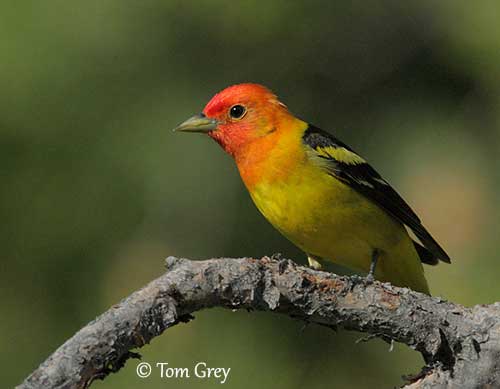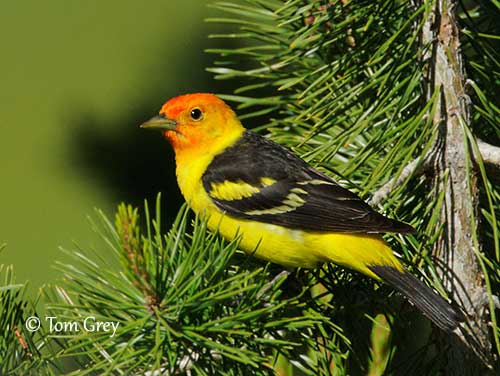
Fr: Tangara à tête rouge - Piranga à tête rouge
Ang: Western Tanager
All: Kieferntangare
Esp: Piranga Carirroja
Ita: Tanagra occidentale
Nd: Louisianatangare
Sd: västlig tangara
Photographer:
Tom Grey
Tom Grey's Bird Pictures & Tom Grey's Bird Pictures 2
Text by Nicole Bouglouan
Sources:
HANDBOOK OF THE BIRDS OF THE WORLD Vol 16 by Josep del Hoyo- Andrew Elliot-David Christie – Lynx Edicions – ISBN: 9788496553781
BIRDS OF THE GREAT BASIN – by Fred A. Ryser - University of Nevada Press - ISBN: 0874170796
Avibase (Denis Lepage)
Birdlife International
Animal Diversity Web (University of Michigan Museum of Zoology)
All About Birds (Cornell Lab of Ornithology)
The Birds of North America online
What Bird-The ultimate Bird Guide (Mitchell Waite)
Bird Web (Seattle Audubon Society)
Wikipedia, the free encyclopaedia
Western Tanager
Piranga ludoviciana
Passeriformes Order – Cardinalidae Family
INTRODUCTION:
The Western Tanager is the western counterpart of the Scarlet Tanager from the east. It usually occurs farther north than any other tanager species in summer, and can be seen far up into NW Canada.
This species frequents open coniferous forests, aspen groves and mahogany stands on mountainsides.
It feeds on insects, fruits and berries, and forages mainly at treetops. The shallow, cup-shaped nest is built by the female in coniferous tree species.
The Western Tanager is relatively common throughout the large range, and the species is not globally threatened for the moment.

DESCRIPTION OF THE BIRD:
Biometrics:
Length: 17-18 cm
Wingspan: 28-30 cm
Weight: 22,5-36 gr
The Western Tanager male in breeding plumage has the entire head more or less bright red, becoming yellow on neck and breast and most of the underparts.
On the upperparts, mantle, scapulars and wings are black, except for two pale wingbars formed by the bright yellow median coverts and the pale tips and edges of other feathers. The wings are rounded. The fan-shaped tail is black.
The bill is greyish with yellowish tinge. The eyes are dark brown. Legs and feet are grey.
The non-breeding male shows similar but duller plumage. The head is duller with the red colour often restricted to the face. The back may appear mottled black.
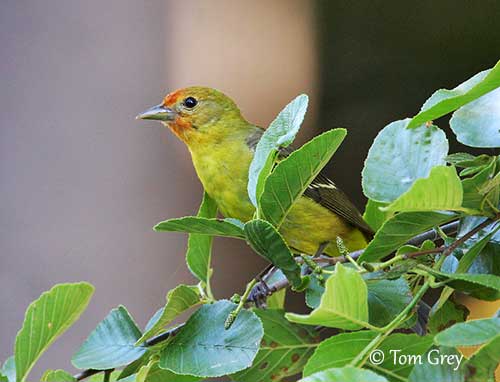
The female has two colour morphs.
The yellow morph is similar to the male but the head is dull yellow, not red. Back and wings are mostly grey with weak pale wingbars. The bill is paler too.
The grey morph is greyer and duller, and generally more uniform. The bill is more yellowish.
The juvenile resembles female. It is sexually mature after two years.
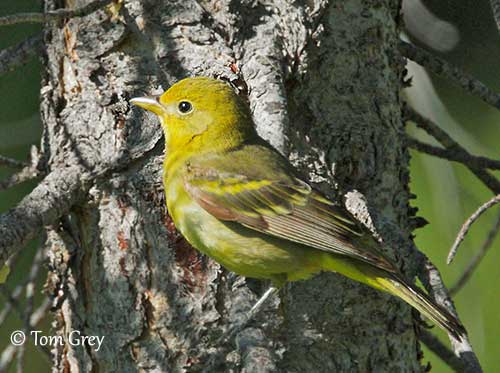
RANGE:
The Western Tanager breeds in S Alaska and W Canada, then S in W USA (E to Wyoming and C Colorado) to SW California, S Arizona, New Mexico and SW Texas, and extreme NW Mexico (Baja California).
It migrates to S California (rare) and mountains of W Mexico, S locally to Costa Rica and rarely to W Panama.
This distribution follows the forest along the W coasts of North and Central Americas, from Alaska all the way to Panama.
HABITAT:
The Western Tanager breeds in open coniferous forests and mixed woodlands, between 1,000 and 3,000 metres of elevation, but around 450 metres in Washington and up to 2,300 metres in SW USA.
During the winter and on migration, it is found in open pine woodlands, parks, gardens, desert oases and orchards.
CALLS AND SONGS: SOUNDS BY XENO-CANTO
The Western Tanager’s calls are short and explosive. They are given by male and female, and also by their young. The main call is a dry “pit-r-ick” and the bird gives a soft whistle “weet” in flight.
The song resembles that of the American Robin, but it is hoarser and lower-pitched. It is more frequent in male with 4-7 song phrases “pir-ri pir-ri pee-wi pir-ri pee-wi” with rising and falling inflections. The song of the female is more repetitive with 2-5 phrases. The sounds uttered by the young birds are more musical.
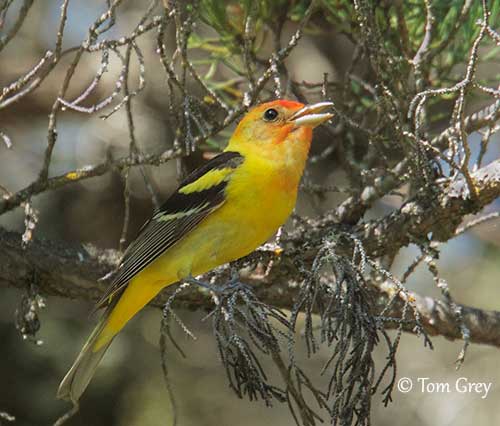
BEHAVIOUR IN THE WILD:
The Western Tanager feeds primarily on insects such as wasps, bees, ants, beetles, grasshoppers, termites and cicadas. It may fly to catch flying prey, or peers about slowly in foliage. It forages mainly at treetops by gleaning among large twigs and branches.
In late summer, it also consumes some cultivated fruits and numerous berries including mulberries and elderberries. It also regularly visits flowers, probably feeding on nectar and insects.
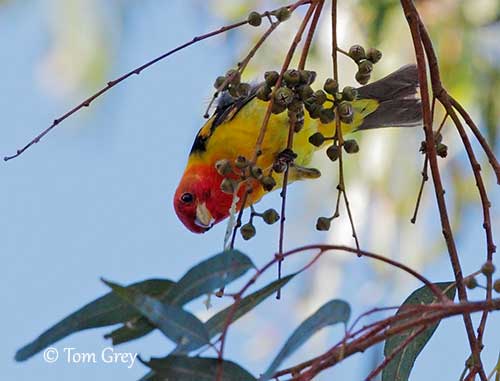
In late spring and summer, the male sings to defend the territory. The courtship displays includes chases between male and female. The pair forms during the migration or on the wintering grounds. They are socially monogamous, but some males may move outside their territories to mate with other females.
The female performs most of nesting duties but the chicks are fed by both parents.
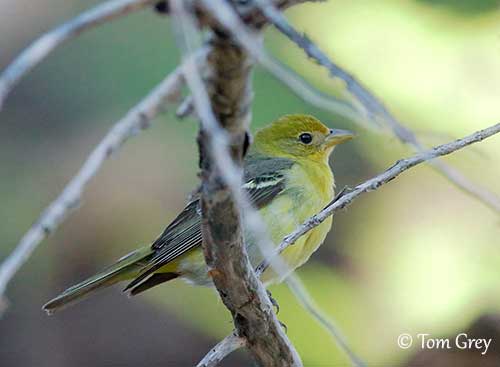
The Western Tanager is migratory and travels over long distances alone, in pairs or in groups of about 30 individuals. They migrate at night and fly very high.
From an observation, the Western Tanager flying across hot regions of southern California takes advantage of large trees and shrubs for resting and foraging. It is not noted drinking water, but the diet including insects, fruits and berries probably provides enough water to the bird. The migratory birds are usually fat and in good shape.
The Western Tanager has swift, direct flight with rapid wingbeats.
REPRODUCTION OF THIS SPECIES:
The breeding season takes place between May and July.
The female builds the nets in coniferous tree, or sometimes in deciduous species. The shallow, open, cup-shaped nest is made of twigs, grass and rootlets, and lined with softer material such as animal hair and fine rootlets. It is placed at a fork in horizontal branch out of the trunk, between 2 and 20 metres above the ground. She is fed by the male during both nest building and egg laying.
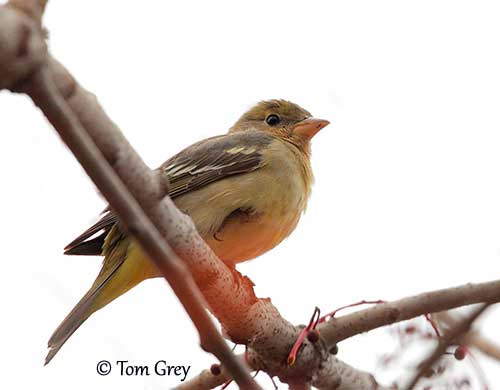
The female lays 3-5 pale blue to bluish-green eggs with brown markings. She incubates alone during about 13 days, and the chicks are fed by both parents. They usually fledge within two weeks, and become independent 15 days later.
PROTECTION / THREATS / STATUS:
The Western Tanager is described as uncommon to locally fairly common throughout the large range. The breeding habitat in national forests and protected areas is at relatively low risk. However, the wintering range is threatened by deforestation and fragmentation, although it also includes intact habitats.
The size of the population is unknown, but this species is suspected to be slowly increasing.
The nest is parasitized by the Brown-headed Cowbird. The Blowfly larvae (family Calliphoridae) are known to invade the fledglings, involving their death.
But currently, the Western Tanager is not globally threatened and evaluated as Least Concern.
